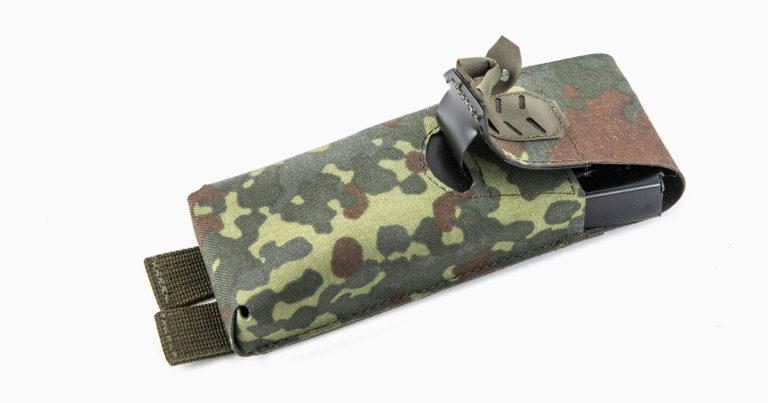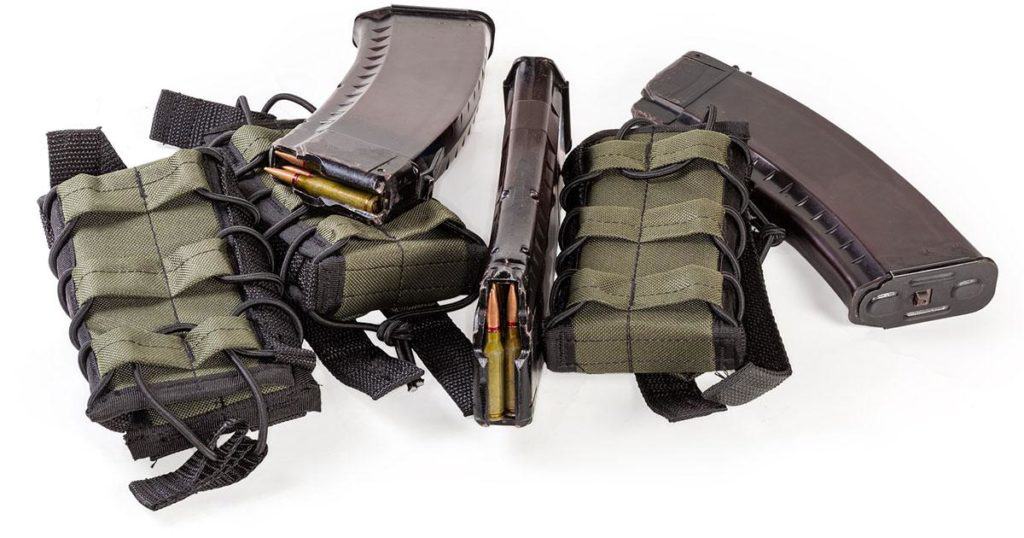As the name already suggests, a magazine pouch is a device designed to hold a magazine in place, and it is generally used to carry an extra magazine. Since the advent of firearms, pouches in many forms have been used to hold ammunition.
The concept of magazines in handheld firearms dates back to the development of the first rifle with a detachable magazine known as the Savage 99. However, the first real example of the magazine can be found with the Gatling gun developed in 1861.
This detailed mag pouch guide will aim at elaborating on the concept of a magazine pouch, and how you should choose one for yourself.

What Are the Different Types of Mag Pouches
With all the versatility present in firearms and their magazines, it is quite obvious that magazine pouches come in a wide variety of shapes and sizes. The right classification for this can be made on the basis of design, functionality, and even build quality.
Single, Double, or Multiple Mag Pouches
A magazine pouch can either have the space to accommodate a single magazine, a couple of magazines, or maybe an entire array of magazines. Each of these designs is intended to suit different applications pertaining to different situations. For example, a single pouch is suitable for everyday carry, a double mag pouch is good for active duty LEOs, and multiple mag pouches is perfect for military personnel.
Concealed or Open Carry Mag Pouches
Just like concealed carry holsters, there are mag pouches that can be carried in the same manner. These magazine pouches sit inside the waistband and offer perfect concealment with their low profile, especially when blended with the right clothing.
Some states allow open carry of weapons, and in those states, an open carry or exposed mag pouch may seem more viable. Such exposed pouches are also great for active duty personnel as they offer easy and quick access to the mag. However, one must also consider getting an excellent retention system with such pouches.
Open Top or Closed Top Mag Pouches
Some mag pouches may feature a flap on the top which is used to cover the exposed part of the magazine. Such flaps can be helpful in preventing dirt from entering the mag, and also protecting the bearer against cuts and bruises.
On the other hand, many mag pouches come with an open-top design allowing for quick access. Choosing between these two is entirely a matter of personal preference.
Mag Pouches Based upon Retention
Some magazine pouches differ on the basis of their retention mechanism. A mag pouch can have a bungee cord, elastic material design, or a screw-based retention system. While the bungee cord retention mechanism is mostly favored by airborne troops, elastic retention can be suitable for tactical use, and screw-based systems are perfect for civilian-based applications.
What Are the Most Common Materials for Making Mag Pouches?
Here are the commonly used materials employed for designing a mag pouch.
Leather
Since the advent of firearms, leather has been a widely used material used for designing holsters and mag pouches. Leather pouches are soft on the mag’s surface, and often provide a comfortable fit for the user.
Such pouches mostly do not feature a retention mechanism and only rely upon the tension of the material. Plus, they are the most pricey option and require significant care in the long term.
Kydex
Thermoplastic material is also a very popular choice to create holsters, and the same goes with mag pouches. The most popular plastic-based material for such uses is Kydex, which is heat resistant, water resistant, and durable material. These materials are absolutely maintenance-free and come with a screw-based or active locking retention mechanism.
Kydex-based mag pouches are popular with law enforcement officials because of their durability and quick accessibility.
Nylon
Nylon is a very common material for manufacturing mag pouches these days. The most common types for designing these pouches are ballistic nylon and Cordura nylon. This material is renowned for its lightweight, customizable, and breathable design, along with an insanely inexpensive cost.
Nylon mag pouches are very common with the defense forces due to their breathable design, adjustability, and lightweight. These are worn on chest rigs, right atop the plate carrier, and are also designed to offer MOLLE compatibility. The most prominent supplier for the U.S Military for mag pouches is high-speed gear Inc., and a big number of military personnel are equipped with pouches designed by them..
Factors to Look For When Choosing a Magazine Pouch
There are a few important factors you must keep an eye out for when choosing a mag pouch or custom magazine pouch.
Stable Retention, Easy Access, and Quick Draw Speed
The first and foremost thing to ensure is the proper retention of your mag pouch. A magazine is like a straight bar and can be easily pulled out or misplaced if the retention mechanism is not good enough to retain it.
As I have already described the retention mechanism in the above section, you can easily infer the best type suiting your requirements.
Whether it is a gun holster or a magazine pouch, it is imperative to ensure easy and quick access. Different situations present different challenges, and it is important to stay prepared for your intended situation.
A quick and easy retrieval is extremely crucial when the user is doing things like a tactical reload. A smooth draw and reliable holstering, along with stable retention are extremely essential for tactical applications, like with the military and police.

Specific Fit or Universal Fit
A magazine pouch may either be suitable for a specific magazine, or it may have a unifit design that can accommodate any magazine for the respective class of firearms. Pouches designed for specific magazines seem to be a great idea if you are always sure about what weapon you are going to carry. A pouch specifically designed for semi-autos will differ from those designed for revolvers, and so on.
However, if that is not the case with you, your choice of weapons is quite versatile. A universal fit mag pouch such as an elastic design or an adjustable design will suit your needs.
Compatibility with MOLLE
MOLLE is an acronym for Modular Lightweight Load-carrying Equipment. It is a sort of webbing that is stitched onto military backpacks and tactical rigs which allows the user to mount or dismount MOLLE-compatible gear.
Nylon-based mag pouches generally feature innate MOLLE compatibility. However, if your pouch does not offer that, you can choose an adapter to fit. I think MOLLE compatible pouches are a better choice if you are involved in tactical activities, or need to carry your gear outdoors for prepper exercises or camping.The Helium Whisper MOLLE attachment system from blue force gear is a good adapter if you need one.
Level of Noise
A magazine rattling inside your pouch is not a good thing. Similarly, the pouch getting rubbed against foliage can also break the element of surprise. Thermoplastic pouches are quite notorious for this, so keep an eye out for that.
Comfort and Concealment
As the mag pouch will always sit close to your body, it is important that it offers a snug fit, both for you and your magazines. A good feature to look out for is a movable mounting position, so you can adapt according to different situations.
Adjustability and Build
Adjustability for your mag pouch offers versatility and also compatibility with different mags and platforms. Similarly, good build quality will ensure the pouch lasts longer and does not fail when it is needed the most.
Water Retention
While this factor may seem quite insignificant to many people reading this, a water-resistant mag pouch that allows water to flush out is very helpful in maritime or rainy environments. It also helps reduce the overall weight of the tactical gear. That is why most military mag pouches are just a strip of nylon woven over by a bungee or Cordura cord.
Conclusion
Magazine pouches come in many sizes and designs. Some of them are designed to suit specific mags, whereas others can have a more universal fit. A good pouch must offer stable retention, easy access, a quick draw, adjustability and probable compatibility with systems like MOLLE.
2 Comments
Leave a Comment
July 20, 2022

This article on magazine Pouches is an informative guide for anyone looking to optimize their gear for efficient ammunition management. The detailed exploration of different types of magazine pouches, along with considerations for material and design, provides valuable insights into making an informed choice. The emphasis on accessibility and versatility underscores the importance of this often-overlooked gear in tactical situations. As someone who values preparedness, this article offers a helpful perspective on selecting the right magazine pouch to enhance overall functionality. Kudos for shedding light on the significance of this essential accessory!
This mag pouch guide is an absolute gem for anyone navigating the vast landscape of magazine pouch options. The author has done a commendable job in creating a comprehensive resource that simplifies the often overwhelming process of choosing the right mag pouch for different needs.
The breakdown of various types of mag pouches and their specific applications is incredibly useful. Whether you’re an avid shooter, a military professional, or a law enforcement officer, the guide caters to a diverse audience by offering insights into the functionality and advantages of different designs. From open-top pouches for quick access to closed and secured options, the guide provides a clear roadmap for readers to align their choices with their unique requirements.
The consideration of materials is another standout feature. Exploring the pros and cons of materials like nylon, Kydex, and Cordura adds depth to the guide, allowing readers to make informed decisions based on factors such as durability, weight, and overall performance.
What sets this guide apart is its practicality. The author doesn’t just stop at describing the types and materials but goes further to discuss compatibility, ease of use, and considerations for specific scenarios. This hands-on approach ensures that readers not only understand the theory but also gain practical insights into how these mag pouches will perform in real-world situations.
I particularly appreciate the emphasis on user experience. The guide doesn’t just focus on technical details but also factors in the comfort and convenience of the user. This holistic approach is invaluable, especially for those who prioritize both functionality and ergonomic design in their gear.
In conclusion, “The Go-To Mag Pouch Guide” is a must-read for anyone looking to upgrade their gear or delve into the world of magazine pouches. The author’s expertise and attention to detail shine through, making this guide a reliable companion for both beginners and seasoned enthusiasts alike. Kudos to the author for demystifying the complexities of mag pouch selection and providing a go-to resource for the community. Highly recommended!